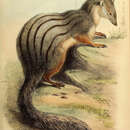pms
nòm ant ël fil


Like other carnivores, euplerids can perceive visual, acoustic, chemical, and tactile signals. Communication is through scent in the form of glandular secretions and through a variety of cries, groans, and other vocalizations.
Communication Channels: acoustic ; chemical
Other Communication Modes: scent marks
Perception Channels: visual ; tactile ; acoustic ; chemical
All species in this family are threatened. Fossa fossana, Galidia elegans, Galidictis fasciata, and Salanoia concolor are considered vulnerable by the IUCN, and Cryptoprocta ferox, Eupleres goudotii, Galidictis grandidieri, and Mungotictis decemlineata are considered endangered. Cryptoprocta ferox, Eupleres goudotii, and Fossa fossana are on Appendix II of CITES. Habitat destruction in the form of deforestation is the main cause of their decline, though hunting by humans and predation by dogs also impact populations.
The family Eupleridae, the Malagasy carnivores, consists of eight species and seven genera in two subfamilies. The diversity of form and function in this family is such that some have suggested it be split into several families.
Cryptoprocta ferox individuals sometimes attack poultry. There are no reports of other euplerids negatively affecting humans.
Euplerids are commonly hunted for their meat.
Positive Impacts: food
Euplerids that eat fruit are primary consumers, and all euplerids are secondary and higher-level consumers, because they eat a variety of animal matter. They, in turn, are eaten by humans and domestic dogs, and possibly other predators as well. Cryptoprocta ferox is the largest native predator on Madagascar and, except for humans, is at the top of the food chain.
Euplerids are primarily carnivorous, consuming small mammals, birds, reptiles, frogs, insects, crustaceans, and other invertebrates. Eupleres goudotii is specialized for eating intertebrates such as earthworms. Fossa fossana and Galidia elegans may include some fruit in their diets in addition to animal matter.
Primary Diet: carnivore (Eats terrestrial vertebrates, Eats eggs, Insectivore , Eats non-insect arthropods); herbivore (Frugivore ); omnivore
Species in the family Eupleridae are restricted to the island of Madagascar.
Biogeographic Regions: ethiopian (Native )
Other Geographic Terms: island endemic
Euplerids live in a variety of habitats, from humid forests, marshes, bogs, and swamps, to deserts and savannahs.
Habitat Regions: temperate ; tropical ; terrestrial
Terrestrial Biomes: desert or dune ; savanna or grassland ; forest ; rainforest ; scrub forest
Wetlands: marsh ; swamp ; bog
Euplerid lifespans in the wild are unknown. Cryptoprocta holds the longevity record in captivity, at 20 years.
Aside from molecular synapomorphies, euplerids have few traits in common. They tend to have slender bodies with relatively small heads and pointed rostra, although fossas (Cryptoprocta ferox) are more cat-like in appearance, with blunt snouts. Head and body length ranges from 250 mm in Mungotictis and Salanoia to 800 mm in adult male Cryptoprocta. The thick, soft pelage is gray or brown, and spotted or striped in all but Eupleres and Cryptoprocta. The foot posture is plantigrade or digitigrade.
Other Physical Features: endothermic ; homoiothermic; bilateral symmetry
Sexual Dimorphism: male larger
No information is available on the specific predators of euplerids, besides humans and domestic dogs, both of which are not native to Madagascar. Cryptic coloration in the form of spots and stripes on neutral backgrounds probably conceals most species well. Eupleres goudotii is known to either run or freeze when disturbed, and Cryptoprocta ferox releases a foul-smelling substance from its anal glands when it is alarmed. Large birds of prey or large snakes are potential predators.
Known Predators:
Anti-predator Adaptations: cryptic
Mating systems in Eupleridae vary, as social structure varies from species to species. Fossas form monogamous pairs, while species in the genera Galidia, Mungotictis, and Salanoia are either found alone or in pairs, suggesting that they are monogamous within, but not across, breeding seasons. Species in the genera Eupleres and Galidictis live alone, in pairs, or in small family groups, which also might indicate monogamy. Mungotictis individuals live in small groups with several adults of each sex, but it is not known whether all of the adults within a group breed. Cryptoprocta individuals are strictly solitary, suggesting a polygynous or polygynandrous mating system.
Mating System: monogamous ; polygynous ; polygynandrous (promiscuous)
Euplerids have definite breeding seasons, which vary by species and last anywhere from two to eight months. Gestation lasts around three months. Usually there are just one or two young per litter, though Cryptoprocta can have up to four. Weaning takes place between two and four and a half months.
Key Reproductive Features: semelparous ; seasonal breeding ; gonochoric/gonochoristic/dioecious (sexes separate); sexual ; fertilization ; viviparous
Like all eutherian mammals, euplerid females nuture their young through a placenta until the young are born. They then provide their offspring with milk for two to four and a half months. Females of some genera, such as Cryptoprocta, select dens in which to bear and nurse their young. Mungotictis individuals live in family groups of several adults, juveniles, and young; thus, offspring have an association with their parents beyond weaning.
Parental Investment: pre-fertilization (Provisioning, Protecting: Female); pre-hatching/birth (Provisioning: Female, Protecting: Female); pre-weaning/fledging (Provisioning: Female, Protecting: Male, Female); pre-independence (Provisioning: Female, Protecting: Male, Female); post-independence association with parents